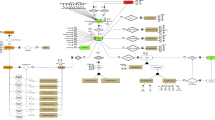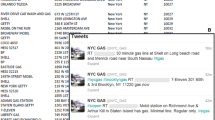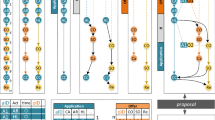Abstract
In the modern world of technology, the ontology is considered as an important factor in integrating data and creating semantic links between concepts. Given the reasoners and tools provided, processing is possible on the information stored in the ontology. Since description logic, as a formal language in the expression of ontologies, lacks the necessary means to create a time dimension in the relationship between data, hence, new semantic web tools can help descriptive logic to create the capability to process and deduce of temporal relationships. In this regard, identifying methods for modeling time and how it relates to other non-temporal concepts in the ontology can be very significant. Research on the history of science with a focus on the concepts of time and temporal queries is scarce. This manuscript aims to study a set of papers on the history of medical sciences to extract recurrent patterns of queries. In the following, an ontology of the medical history was created comprising the two Islamic medical and European scientific revolution eras, and the queries were expressed in SQWRL according to the proposed model. In this research, the N-array and SWRL temporal models have been used for time concepts.





Similar content being viewed by others
Notes
These API’s can be found respectively at http://owlapi.sourceforge.net/ and https://github.com/protegeproject/swrlapi.
References
Anagnostopoulos E, Batsakis S, Petrakis EG (2013) CHRONOS: a reasoning engine for qualitative temporal information in OWL. Procedia Comput Sci 22:70–77
Analyti A, Pachoulakis I (2012) A survey on models and query languages for temporally annotated RDF. Int J Adv Comput Sci Appl 3(9):28–35
Artale A, Franconi E, Wolter F, Zakharyaschev M (2002) A temporal description logic for reasoning over conceptual schemas and queries. In: European workshop on logics in artificial intelligence. Springer, Berlin, pp 98–110
Allen JF (1984) Towards a general theory of action and time. Artif Intell 23(2):123–154
Baader F, Borgwardt S, Forkel W (2018).Patient selection for clinical trials using temporalized ontology-mediated query answering. In: Companion of the the web conference 2018 on the web conference 2018. International World Wide Web Conferences Steering Committee, pp 1069–1074
Bahadorani B, Zaeri A (2017) Comparison of time concept modeling for querying temporal information in OWL and RDF. Int J Inf Technol Comput Sci (IJITCS) 9(7):26–34
Batsakis S, Antoniou G, Tachmazidis I (2015) Integrated representation of temporal intervals and durations for the semantic web. In: New trends in database and information systems II. Springer, Cham, pp 147–158
Batsakis S, Petrakis EG (2011) Representing temporal knowledge in the semantic web: the extended 4D fluents approach. In: Combinations of intelligent methods and applications. Springer, Berlin, pp 55–69
Batsakis S, Petrakis EG (2010) SOWL: spatio-temporal representation, reasoning and querying over the semantic web. In: Proceedings of the 6th international conference on semantic systems. ACM, p 15
Barbieri DF, Braga D, Ceri S, Valle ED, Grossniklaus M (2010) C-SPARQL: a continuous query language for RDF data streams. Int J Semant Comput 4(01):3–25
Baratis E, Petrakis EG, Batsakis S, Maris N, Papadakis N (2009) TOQL: temporal ontology querying language. In: International symposium on spatial and temporal databases. Springer, Berlin, pp 338–354
Baader F, Calvanese D, McGuinness D, Patel-Schneider P, Nardi D (eds) (2003) The description logic handbook: theory, implementation and applications. Cambridge University Press, Cambridge
Berners-Lee T, Hendler J, Lassila O (2001) The semantic web. Sci Am 284(5):28–37
Bettini C (1997) Time-dependent concepts: representation and reasoning using temporal description logics. Data Knowl Eng 22(1):1–38
Corda I (2007) Ontology-based representation and reasoning about the history of science. Doctoral dissertation, University of Leeds, School of Computing
Davies J, Studer R, Warren P (eds) (2006) Semantic Web technologies: trends and research in ontology-based systems. Wiley, New York
Deng N (2018) What is temporal ontology? Philos Stud 175(3):793–807
Embregts H, Milea V, Frasincar F (2014) Metafrastes: a news ontology-based information querying using natural language processing. In: The 8th international conference on knowledge management in organizations. Springer, Dordrecht, pp 313–324
Ermolayev V, Batsakis S, Keberle N, Tatarintseva O, Antoniou G (2014) Ontologies of time: review and trends. Int J Comput Sci Appl 11(3):57–115
Fisher M (2011) An introduction to practical formal methods using temporal logic, vol 82. Wiley, Hoboken
Frasincar F, Milea V, Kaymak U (2010) towl: integrating time in owl. In: Semantic web information management. Springer, Berlin, pp 225–246
Fisher MD, Gabbay DM, Vila L (eds) (2005) Handbook of temporal reasoning in artificial intelligence, vol 1. Elsevier, Amsterdam
Grandi F (2010) T-SPARQL: a TSQL2-like temporal query language for RDF. In: ADBIS (local proceedings), pp 21–30
Gutierrez C, Hurtado CA, Vaisman A (2006) Introducing time into RDF. IEEE Trans Knowl Data Eng 19(2):207–218
Golbreich C, Mercier S (2004) Construction of the dialysis and transplantation ontology: advantages, limits, and questions about Protege OWL. In: Workshop on medical applications of Protégé, 7th international Protégé conference, Bethesda
Hobbs JR, Pan F (2006) ontology in OWL. W3C Work Draft 27:133
Hobbs JR, Pan F (2004) An ontology of time for the semantic web. ACM Trans Asian Lang Inf Process 3(1):66–85
Horrocks I, Patel-Schneider PF, Boley H, Tabet S, Grosof B, Dean M (2004) SWRL: a semantic web rule language combining OWL and RuleML. W3C Memb Submiss 21(79):1–31
Hobbs JR, Ferguson G, Allen J, Hayes P, Niles I, Pease A (2002) A daml ontology of time. http://www.cs.rochester.edu/_ferguson/daml/daml-time-20020830.txt
Jovic A, Prcela M, Gamberger D (2007) Ontologies in medical knowledge representation. In: 2007 29th international conference on information technology interfaces. IEEE, pp 535–540
Khan F, Bellandi A, Frontini F, Monachini M (2017) Using SWRL rules to model noun behaviour in Italian. In: International conference on language, data and knowledge. Springer, Cham, pp 134–142
Krieger HU (2010) A general methodology for equipping ontologies with time. In: LREC
Kim SK, Song MY, Kim C., Yea SJ, Jang HC, Lee KC (2008) Temporal ontology language for representing and reasoning interval-based temporal knowledge. In: Asian semantic web conference. Springer, Berlin, Heidelberg, pp 31–45
Kim J (1976) Events as property exemplifications. In: Action theory. Springer, Dordrecht, pp 159–177
Lutz C, Wolter F, Zakharyaschev M (2008) Temporal description logics: a survey. In: 2008 15th international symposium on temporal representation and reasoning. IEEE, pp 3–14
Mishra RB, Kumar S (2011) Semantic web reasoners and languages. Artif Intell Rev 35(4):339–368
Maris N (2008) A reasoner for querying temporal ontologies. Dissertation. Department of Sciences, TEI of Crete
Mach-Król M (2015) Nonlinear time structures and nonlinear time ontology for description of economic phenomena. In: Mach-Król M, Olszak CM, Pełech-Pilichowski T (eds) Advances in ICT for business, industry and public sector. Springer, Cham, pp 77–88
Noy N, Rector A, Hayes P, Welty C (2006) Defining N-ary relations on the semantic web. W3C working group note. World Wide Web Consortium (W3C)
O’Connor MJ, Das AK (2010) A method for representing and querying temporal information in OWL. In; International joint conference on biomedical engineering systems and technologies). Springer, Berlin, Heidelberg, pp 97–110
O’Connor MJ, Das AK (2009). SQWRL: a query language for OWL. In: OWLED, vol 529
O’Connor MJ, Shankar RD, Nyulas C, Tu SW, Das AK (2008) Developing a web-based application using OWL and SWRL. In: AAAI spring symposium: AI meets business rules and process management, pp 93–98
O’Connor M, Tu S, Nyulas C, Das A, Musen M (2007) Querying the semantic web with SWRL. In: International workshop on rules and rule markup languages for the semantic web. Springer, Berlin, Heidelberg, pp 155–159
O’Connor MJ, Tu SW, Musen MA (2002) The Chronus II temporal database mediator. In: Proceedings of the AMIA symposium. American Medical Informatics Association, p 567
Preventis A, Petrakis EG, Batsakis S (2014) Chronos Ed: a tool for handling temporal ontologies in Protege. Int J Artif Intell Tools 23(04):1460018
Papadakis N, Stravoskoufos K, Baratis E, Petrakis EG, Plexousakis D (2011) PROTON: A prolog reasoner for temporal ontologies in OWL. Exp Syst Appl 38(12):14660–14667
Pérez J, Arenas M, Gutierrez C (2009) Semantics and complexity of SPARQL. ACM Trans Database Syst (TODS) 34(3):16
Selvalakshmi B, Subramaniam M (2018) Intelligent ontology based semantic information retrieval using feature selection and classification. Cluster Comput. https://doi.org/10.1007/s10586-018-1789-8
Sirin E, Parsia B, Grau BC, Kalyanpur A, Katz Y (2007) Pellet: a practical owl-dl reasoner. Web Semant Sci Servi Agents World Wide Web 5(2):51–53
Tao C, Solbrig HR, Chute CG (2011) CNTRO 2.0: a harmonized semantic web ontology for temporal relation inferencing in clinical narratives. In: AMIA summits on translational science proceedings, p 64
Tao C, Wei WQ, Solbrig HR, Savova G, Chute CG (2010) CNTRO: a semantic web ontology for temporal relation inferencing in clinical narratives. In; AMIA annual symposium proceedings. American Medical Informatics Association, vol 2010, p 787
Tappolet J, Bernstein A (2009) Applied temporal RDF: efficient temporal querying of RDF data with SPARQL. In: European semantic web conference. Springer, Berlin, Heidelberg, pp 308–322
Welty C, Fikes R, Makarios S (2006) A reusable ontology for fluents in OWL. In: FOIS, vol 150, pp 226–236
Zilli A (ed) (2008) Semantic knowledge management: an ontology-based framework: an ontology-based framework. IGI Global, Pennsylvania
Author information
Authors and Affiliations
Corresponding author
Rights and permissions
About this article
Cite this article
Bahadorani, B., Zaeri, A. A method for using temporal reasoners to answer the history of science questions. Int. j. inf. tecnol. 12, 181–188 (2020). https://doi.org/10.1007/s41870-019-00373-z
Received:
Accepted:
Published:
Issue Date:
DOI: https://doi.org/10.1007/s41870-019-00373-z




